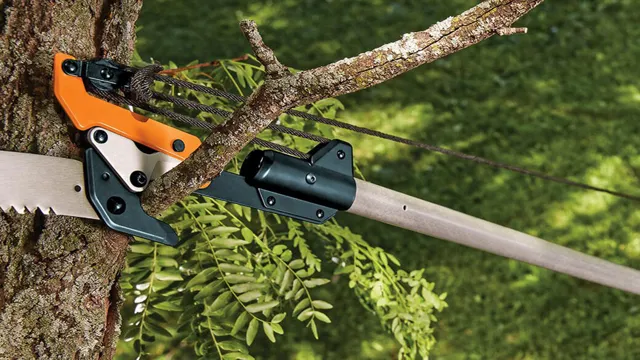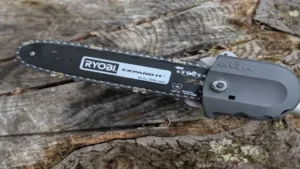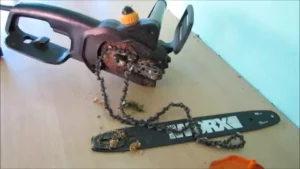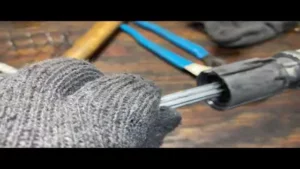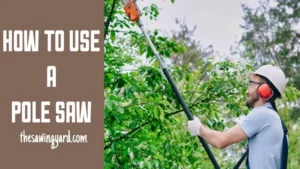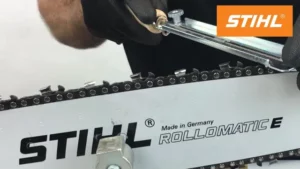Have you ever wondered how to tackle those overgrown branches that seem to be too high to reach? Fear not, because we have the solution for you: the manual pole saw. A manual pole saw is a perfect tool for pruning high branches, making it a great investment for any homeowner. Using a manual pole saw may seem intimidating at first, but with patience and practice, it can become a routine part of your gardening routine.
Think of it as a cross between a traditional saw and a pair of scissors, where the long handle allows you to reach taller branches without the need for a ladder. By mastering the art of the manual pole saw, you’ll not only improve the aesthetics of your yard but also promote the health of the tree by removing dead or diseased branches. In this beginner’s guide, we’ll cover the basics of using a manual pole saw, from selecting the right tool for the job, to proper techniques for using it safely and effectively.
With the right mindset and some practice, you’ll be a pro at pruning in no time. So grab your manual pole saw and let’s get started!
Overview
If you’re in need of pruning or trimming trees around your property, a manual pole saw is a great tool to have on hand. These saws can extend up to 20 feet or more, allowing you to reach high branches without needing a ladder or other dangerous equipment. To use a manual pole saw, start by identifying the branch you want to cut.
Begin sawing close to the base of the branch and work your way out. Take care to keep the saw blade positioned correctly for each cut, and make sure to apply enough pressure to make a clean cut. Always wear appropriate safety gear, including eye protection and gloves, when using a manual pole saw.
With a little practice and patience, you’ll soon be confidently pruning even the highest branches on your trees.
What is a manual pole saw and why use it?
A manual pole saw is a handy tool that extends your reach to trim tree limbs or shrubs that are too tall to prune with a handheld saw. It’s essentially a long pole with a saw blade at the end, which allows you to keep your feet safely on the ground while you trim up high. This tool is ideal for homeowners with smaller yards and fewer trees to maintain.
Manual pole saws come in different sizes, depending on the height of the tree you’re working on, and their blades vary in length too. They’re lightweight, easy to store and transport, and don’t require any maintenance. Plus, they’ll save you money in the long run as they don’t require any gas or electricity to operate.
Overall, a manual pole saw can be a useful addition to your gardening tools for keeping your trees healthy and attractive.

Parts of a manual pole saw
A manual pole saw is a garden tool used to trim tall trees and branches. It consists of several parts that work together to make it efficient and easy to use. The most notable part of a manual pole saw is the blade, which is the cutting tool that comes in various lengths and types.
The blade can be fixed or adjustable and can be attached or detached from the pole. The pole is the long handle of the pole saw and can be made from fiberglass, aluminum, or wood. It is designed to provide leverage and reach, making it possible to trim high branches.
The grip is the part of the pole saw that you hold onto while working. It should be ergonomic and comfortable to prevent fatigue and strains on your hands. Finally, the locking mechanism is the safety feature that holds the blade in place when not in use.
When choosing a manual pole saw, consider the material of the pole, the weight, the length of the blade, and the type of grip that feels comfortable for you. By doing so, you can ensure that you have a reliable tool that can handle all your pruning needs.
Preparing to Use
If you’ve recently purchased a manual pole saw, or you’re considering getting one, you’ll want to prepare yourself to use it safely and efficiently. The first step is to read the instruction manual thoroughly. Make sure you understand how to assemble the pole saw, as well as any safety features included.
Check that all screws and bolts are tightened before use, and that you have the correct tools, such as a file or sharpening stone, for maintaining the blades. It’s important to dress appropriately, using gloves, long pants, and sturdy shoes with good traction. Additionally, ensure the area where you’ll be using the pole saw is free of obstacles, people, and pets.
Doing so will reduce the chances of accidents or damage to property. By taking these precautions and familiarizing yourself with the tool, you’ll be able to enjoy the benefits of a well-designed manual pole saw while avoiding common mishaps and injuries.
Inspecting the pole saw and nearby area
Before using a pole saw, it is important to inspect the tool and the surrounding area to ensure safety. Give the saw a quick once-over to ensure that all the screws are nice and tight, the blade is sharp and well-oiled, and the chain tension is adjusted correctly. This will help prevent any accidents while in use.
Next, check the area where you will be using the saw. Look for any potential hazards like loose branches or power lines that may pose a danger while operating the tool. It’s also crucial to alert anyone in the vicinity of your intentions to use the saw to prevent accidents.
Ensuring that the pole saw and the nearby area are safe will make the task at hand more comfortable and less risky. Remember to always prioritize your safety, and the safety of others when it comes to using any power tools.
Choosing the right blade for the job
When it comes to using a blade for any cutting task, it’s important to choose the right one for the job. After all, not all blades are created equal, and using the wrong one could result in a less-than-ideal cut or even injury. Before even picking up a blade, take the time to assess the task at hand and determine which type of blade will be most effective.
Consider factors like the material you’re cutting, the thickness of the material, and any special features required for the job. Taking these factors into account will help ensure you choose the best blade for the job, and make for a more successful and efficient cutting experience.
Wearing proper safety gear
Wearing proper safety gear is vital when engaging in any task, whether it be in the workplace or at home. The first step to preparing to use any safety gear is to ensure that you have the right equipment. This includes gloves, a hard hat, goggles, and a mask.
It is essential to carefully read the manufacturer’s instructions on each safety gear item to ensure that you are wearing it correctly and that it is the right fit for you. A common mistake is to wear safety gear that is too big or too small, which can lead to accidents. It is also important to make sure that any safety gear is kept in good condition to ensure maximum effectiveness.
Finally, remember that wearing safety gear is not just for your benefit, but also for the people around you, including coworkers and family members. By taking the appropriate precautions, you can create a safer environment for everyone involved and avoid unnecessary injuries.
Using the Pole Saw
If you’re looking to trim those high branches without having to climb a ladder, a manual pole saw could be just what you need. But if you’re new to using one, it can be a bit intimidating. Don’t worry; it’s not as complicated as it looks! To use a manual pole saw, first, make sure the saw blade is sharp and securely attached to the pole.
Then, adjust the pole to the appropriate length for the job. You want to make sure you can reach the branches comfortably without overreaching. When you’re ready to start cutting, aim for the branch’s collar – the slightly raised ring where it meets the trunk.
First, make a small notch on the underside of the branch about halfway through. Then saw through the branch from the top, just outside the notch. Finally, remove the remaining stub by cutting close to the collar.
With a little practice, you’ll be trimming those high branches like a pro!
Positioning yourself and the pole saw
When using a pole saw, it is essential to position yourself properly for safety and efficiency. Start by standing on a flat surface, ensuring there are no obstacles in your way. Hold the pole saw firmly with both hands, keeping it close to your body for stability.
Then, extend the pole saw to the desired height, making sure not to overreach or strain yourself. It’s important to maintain a comfortable distance from the saw’s cutting end and keep your body out of the way of falling branches. When cutting, use smooth, steady motions to avoid any jerking or sudden movements that could throw off your balance.
With the right position and technique, using a pole saw can be a breeze.
Starting the cut
Starting the cut with a pole saw is an essential aspect of maintaining your garden. A pole saw, unlike a chainsaw, has an elongated arm designed to reach high spots in trees while keeping your feet on the ground. Before starting, ensure you are in the proper position with the pole saw in hand.
Ensure you’re standing firm on the ground with the pole’s curved end on the tree you want to cut. Next, grip the saw firmly with both hands and switch it on. Begin by making a slight path on the tree bark and avoid tilting the saw too much.
Try cutting through the smaller branches first before tackling the medium and larger ones. Remember to maintain a steady pace and angle to make clean and precise cuts. With these steps, starting the cut with a pole saw becomes an effortless and enjoyable job, with the added advantage of being able to cut twigs and deadwood without the need for a ladder.
Making the cut
When it comes to cutting down limbs and branches from trees, using a pole saw can make things a lot easier and safer. With its extendable reach and sharp saw blade, you can trim away from a distance without risking injury. However, to truly make the cut, it’s essential to follow some basic guidelines.
Firstly, make sure that the saw is sharpened and properly lubricated before use. Secondly, ensure that you have a firm and stable footing, especially when using the extended reach of the pole saw. Thirdly, be aware of your surroundings, including any potential hazards such as power lines and other obstacles.
By taking these precautions, you can make the cut cleanly, effectively, and safely.
Safety Tips and Maintenance
When it comes to using a manual pole saw, safety should always be your top priority. Before you start working, make sure the area is clear of any obstacles and that you’re wearing proper safety gear, including gloves and eye protection. When positioning the saw, be mindful of where the blade is pointing and keep it away from your body and other people.
It’s also important to maintain the saw properly to ensure its longevity and effectiveness. This includes cleaning the blade after each use, sharpening it as needed, and keeping it oiled to prevent rust and corrosion. By following these safety tips and properly maintaining your manual pole saw, you’ll be able to use it effectively and safely for years to come.
Staying safe while using a manual pole saw
When using a manual pole saw, staying safe should be your top priority. One of the most important safety tips is to wear protective gear, including gloves, eye protection, and a hard hat. Always make sure to inspect your pole saw before use, ensuring that it is in good condition and the blade is sharp.
It is also important to use the saw properly by following the manufacturer’s instructions and not pushing it beyond its limits. Keeping your work area clear of obstacles and ensuring that the pole saw is stable and secure can also prevent accidents. When transporting the saw, be sure to secure it properly to avoid any mishaps.
Lastly, proper maintenance of your pole saw, such as cleaning and oiling the blade, can extend its life and ensure safe operation. Always remember that accidents can happen even with the best safety precautions, so it is important to stay vigilant and focused when operating a manual pole saw. Stay safe out there!
Proper maintenance to ensure longevity and effectiveness
Proper maintenance is essential when it comes to ensuring the longevity and effectiveness of your equipment. Particularly when it comes to safety equipment, regular upkeep is critical to guarantee that it will work correctly when you need it most. First of all, it’s important to understand the manufacturer’s recommended maintenance schedule.
Follow these guidelines to ensure your equipment is in top condition. Always inspect your safety equipment before use and after exposure to extreme conditions, such as high temperatures, humidity, or physical impact. If you notice any signs of damage or wear, replace the equipment immediately.
Additionally, cleaning your safety equipment after use is crucial to prevent contamination and extend its lifespan. Utilize the appropriate cleaning agents specified by the manufacturer, and never use harsh chemicals that could compromise the integrity of the equipment. Remember, proper maintenance can ultimately save you time, money and possibly even your life.
Conclusion
In summary, using a manual pole saw is like conducting a symphony with the perfect blend of strength, dexterity, and finesse. It requires you to channel your inner lumberjack while tapping into your zen-like tendencies. By following the steps we’ve outlined and putting in a little practice, you’ll be pruning like a pro in no time.
So, get ready to embrace your inner tree whisperer and make your yard a work of art!”
FAQs
What is a manual pole saw?
A manual pole saw is a cutting tool that consists of a saw blade on an extendable pole that allows you to reach and trim high branches and limbs.
How do I use a manual pole saw?
To use a manual pole saw, extend the pole to the desired length, position the blade on the branch to be cut, and use a sawing motion to cut through the branch.
What types of branches can I cut with a manual pole saw?
A manual pole saw can cut through branches up to a certain diameter, depending on the type of saw blade and the strength of the user. Typically, it can handle branches up to 4-6 inches in diameter.
Is a manual pole saw safe to use?
Yes, a manual pole saw can be safe to use as long as you follow the manufacturer’s instructions and take appropriate precautions, such as wearing protective gear and using the saw on stable ground.
Can I sharpen the blade of a manual pole saw?
Yes, you can sharpen the saw blade of a manual pole saw using a file. It’s important to keep the blade sharp to ensure efficient cutting and to avoid damaging the tree.
What should I do if the blade of my manual pole saw becomes stuck?
If the blade of your manual pole saw becomes stuck, stop cutting immediately and carefully remove the saw blade from the branch. Check the blade for any damage or debris that may be causing the issue.
Can I use a manual pole saw on a tree that is near power lines?
It is not recommended to use a manual pole saw on a tree that is near power lines, as this can be extremely dangerous. Instead, contact a professional tree service to handle the job safely.
